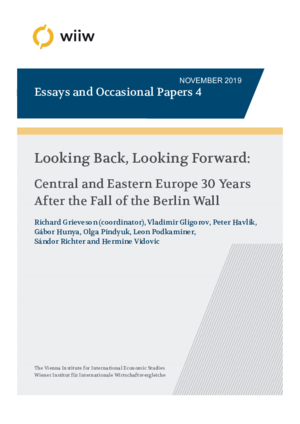Looking Back, Looking Forward: Central and Eastern Europe 30 Years After the Fall of the Berlin Wall
Vladimir Gligorov, Richard Grieveson, Peter Havlik, Gabor Hunya, Olga Pindyuk, Leon Podkaminer, Sandor Richter and Hermine Vidovic
wiiw Essays and Occasional Papers No. 4, November 2019
54 pages including 2 Tables and 29 Figures
To mark the 30th anniversary of the fall of the Berlin Wall, this paper aims to assess developments in Central, East and Southeast Europe (CESEE) over the past three decades, and to look forward to what the next 30 years might bring. First, we measure the convergence of per capita income, wages and life expectancy in CESEE with Western Europe since 1989, and examine demographic trends. We find that, after a difficult start, many countries have become significantly wealthier and their populations much healthier. However, for others, the outcomes of the first 30 years are less positive, and a large number of countries in CESEE have already experienced significant population decline. Second, our experts look back at the situation in 1989, and to what extent their expectations have played out, reflecting on both successes and disappointments. Third, we analyse current trends in the region, and attempt to project what will come next. Here, we focus on automation, digitalisation, institutions, demographics and geopolitics. We find evidence of institutional regression, demographic challenges, and a changing geopolitical backdrop that will have important implications for much of the region. However, we also see reasons for optimism, including the opportunities provided by digitalisation and automation, and an active civil society that could in time force positive change.
Keywords: CESEE, Europe, Central and Eastern Europe, transition, convergence, demographics
JEL classification: E00, E02, F02, J11, P20, P30, O52
Countries covered: Albania, Belarus, Bosnia and Herzegovina, Bulgaria, Central and East Europe, CIS, Croatia, Czechia, Estonia, European Union, Hungary, Kazakhstan, Kosovo, Latvia, Lithuania, Moldova, Montenegro, New EU Member States, North Macedonia, Poland, Romania, Russia, Serbia, Slovakia, Slovenia, Southeast Europe, Turkey, Ukraine
Research Areas: Macroeconomic Analysis and Policy, International Trade, Competitiveness and FDI
Press Releases
Related News
- Eastern Europe has come a long way in 30 years, but faces some serious challenges in a changing world
- Hungary 1989-2019: “Change was unavoidable, but was done perhaps too quickly and radically”
- Looking back, looking forward
- 'Czechoslovakia was one of the most rigid and conservative countries in the former Eastern Bloc'
- “The prospect of EU-membership was the single most important reform driver during the transition period”
